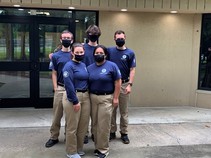
By Region 2 FEMA Corps Team
An AmeriCorps NCCC FEMA Corps team has been serving with Region 2’s National Preparedness Division on several individual and joint emergency preparedness projects since their arrival to the region in July. With educational backgrounds in Criminal Justice, Engineering, Foreign Affairs, History, and Psychology, this team brings unique perspectives and a diverse range of skills and work experience to their service. Members hail from across the United States representing Georgia, Illinois, Pennsylvania, Mississippi, and Virginia.
The team began their service year a few months prior, in March, with trainings from their host campus in Mississippi where they learned about their roles and responsibilities as both AmeriCorps NCCC and FEMA Corps members. The team began their journey in the field with several long days of travel to Rhode Island to begin their first service project working at COVID vaccination centers. At the sites, members worked directly with the public by greeting and directing guests throughout the facilities, checking guests in and providing essential customer service by translating for Spanish-speaking guests, and assisting with data validation to provide quality assurance. In addition to helping the community of Rhode Island vaccinate over 135,000 community members, members made valuable networking connections, improved their customer service and computer skills, and interacted with individuals from various cultures and backgrounds. Read the full article here.
|
August- September 2021

Developing and Organizing your CERT Team to the Max
Tuesday, August 24 at 1:00 PM – 2:30 PM ET
During the week of July 11-19th, 375 citizen volunteers and emergency management professionals came together in Springfield, Missouri for the annual National CERT (Community Emergency Response Team) Conference. Traveling from as far as Hawaii, Alaska and the US Virgin Islands, the participants enjoyed a combination of training, workshops and team building activities to enhance their disaster skills and encourage the sharing of experiences and best practices to benefit all CERT Teams. This webinar series will allow CERTs to hear highlights from the conference without having to leave their home. This session, presented by Lisa Rubey (New Braunsfel CERT), will discuss how to bring your CERT Team to the next level and maximize your CERT strengths. You can register here.
|

Announcing Ready Games for National Preparedness Month
Are you up for the challenge? Please join the Region 2 National Preparedness Division for Ready Games in celebration of National Preparedness Month this September. Every Wednesday, we will host family friendly games where participants can test their knowledge of emergency management concepts. Click on any of the links below to register for a game:
|
 |
 |

FEMA’s Ready Campaign Kicks Off 2021 National Preparedness Month
September is National Preparedness Month. Managed by FEMA’s Ready Campaign, in association with the Ad Council, the month is observed to encourage everyone to take steps to prepare for disasters. This year’s theme, “Prepare to Protect,” highlights how preparing for disasters is protecting everyone you love. For the first time ever, National Preparedness Month will include a series of Hispanic public service advertisements (PSAs), which will be released (in English and Spanish) mid-month, near the start of Hispanic Heritage Month. The PSAs will air during the peak of the hurricane and wildfire seasons. Throughout the month, Ready.gov/September will feature weekly themes that highlight basic preparedness activities that everyone can do. FEMA encourages all partners to participate. The event website contains free, easy to use social media content, additional resources, and more information to help NGOs and EM agencies spread the message.
|
FEMA Launches Full Application of the National Risk Index
FEMA announced the full application launch of the National Risk Index, an online resource that visually identifies traits of the communities most at risk from natural hazards. This online mapping application provides a holistic view of community risk by providing baseline relative risk scores. It measures a community’s risk for 18 natural hazards, in addition to resilience, social vulnerability and expected annual loss. The Index helps users understand natural hazard risk and to support informed risk reduction decisions for mitigation planning and emergency management. By providing standardized risk data and an overview of multiple risk factors, this interactive mapping and analysis tool can help communities, especially those with limited flood mapping and risk assessment capabilities, prepare for natural hazards.
FEMA Region 6 Presents a Podcast on the National Exercise Program
FEMA Region 6 presents the #R6 Prepares Podcast’s latest episode on the National Exercise Program. Joining them are officials from the Texas Division of Emergency Management, who will discuss how the program works at the state and local levels, and how state/local partners can apply for FEMA exercise assistance. Tune in to the podcast by clicking here.
FEMA Releases Guide on Key Planning Factors and Considerations for Response to and Recovery from a Chemical Incident
Key Planning Factors and Considerations for Response to and Recovery from a Chemical Incident is written for response and recovery planners at the regional, state, local, tribal, and territorial levels. A coordinated response and recovery effort will include all levels of government in addition to the private sector, non-governmental organizations, and, potentially, international partners. Planning for a chemical incident requires additional considerations beyond all-hazard preparedness planning, so this document includes strategic and operational issues for consideration when developing response and recovery plans for a chemical incident. The Guide can be found here.
FEMA Releases Emergency Operation Center Toolkit
FEMA has released two Emergency Operations Center toolkit documents. The toolkit is a collection of guidance and best practices for emergency management, specifically the emergency operations center community. These documents include: "Emergency Operations Center How-to Quick Reference Guide" and "Emergency Operations Center References and Resources Tool."
FEMA Releases CERT Position Documents
FEMA has released National Qualification System Job Titles/Position Qualifications and Position Task Books for three National Qualification System Community Emergency Response Team (CERT) positions. The three positions are CERT chief, CERT team leader, and CERT volunteer. These resource typing documents will facilitate the sharing of deployable CERT positions at all jurisdictional levels.
FEMA and FCC Nationwide Alert Test
On Wednesday, August 11 at 2:20pm, FEMA and the FCC coordinated on a test of the nationwide Emergency Alert System (EAS) that broadcast across radios and televisions. Simultaneously, FEMA and the FCC sent out a Wireless Emergency Alert (WEA) by sending text messages to consumer mobile phones in both English and Spanish. To receive the WEA on a mobile phone, a user must have opted-in to the service. Read more about opting-in here.
Region 2 CPO Visits Puerto Rico
Debbie Costa, Region 2’s Community Preparedness Officer, traveled to Puerto Rico earlier this month to meet with partners and advance preparedness initiatives. Along with staff from FEMA’s Puerto Rico Caribbean Area Office (CAO), Debbie met representatives from the Puerto Rico Emergency Management Bureau, Puerto Rico Department of Health, Medical Reserve Corps, Puerto Rico Voluntary Organizations Active in Disaster, Puerto Rico Seismic Network and Mercy Corps. The new Region 2 Youth Preparedness Council Member, Iván Reyes, was also invited to visit the CAO, where he met FEMA staff and received a tour. Click here to see photos from the tour!

COVID-19 Vaccine Update for Homeless Service Providers
COVID-19 has deeply impacted already marginalized communities within the United States in both unprecedented and historically familiar ways. Efforts to increase vaccination rates are growing more urgent as the dangerous Delta variant spreads quickly through communities. To decrease community transmission, all communities must have equitable and easy access to COVID-19 vaccines. To address challenges in vaccinating homeless populations, HUD has released the Vaccine Equity Series of the “COVID-19 Homeless System Response: Vaccine Planning and Distribution” guide. The Vaccine Equity Series focuses on the unique ways in which the histories and lived experiences of BIPOC, AAPI, undocumented, and LGBTQ+ communities can be barriers to vaccine access.
|
Key to NYC Pass
The Mayor of New York City has announced the “Key to NYC” policy starting on August 17, where staff and customers age 12 and older will be required to show proof that have received at least one dose of a COVID-19 vaccine for indoor entertainment, indoor dining, and indoor fitness. Click here to see more details, and how to show proof of vaccination.

Building Codes Throughout History
by Thomas Mendez, Emergency Management Specialist, FEMA Region 2 Mitigation Division
People sometimes complain about design standards and act as if they used to be able to build without encumbrances. Those individuals may think building codes are only a modern entity. But this couldn’t be further from the truth. While they may not be as intricate as they are now, building codes have for millennia been in place. Today we will look at some examples throughout history.
The first building code comes from one of the oldest law codes in history: The Code of Hammurabi. Dating back to approximately 1771 BCE it is filled with fun lines as “If a builder builds a house for someone, and does not construct it properly, and the house which he built falls in and kills its owner, then that builder shall be put to death.” This punishment is obviously extreme that you don’t see in today’s codes, however one passage more up to today’s standards reads “If a builder builds a house for someone, even though he has not yet completed it; if then the walls seem toppling, the builder must make the walls solid from his own mean” demonstrating that, for millennia, a builder may be liable for his or her work. Read the full article here.
|

How Terrorists Could Proceed with Next Physical Attack on Energy Infrastructure
Power outages across much of Texas and rotating blackouts in California over the past year are reminders of the critical importance of reliable electric power. Past large-scale outages in the U.S. have resulted in loss of life, serious injury, social unrest, and economic impacts in the billions of dollars. What about intentional attacks on critical infrastructure? Are threat actors even motivated to conduct physical attacks against electric infrastructure (EI)? If so, can the experts quantify that threat and possibly predict which actors are most likely to conduct such attacks? Click here to read the report.
|
“Return to School Roadmap” Preparing for 2021-2022 School Year
On Aug. 2, the Department of Education released the “Return to School Roadmap,” a resource to support students, schools, educators, and communities as they prepare to return to safe, healthy in-person learning this fall and emerge from the pandemic stronger than before. As part of the launch of the Roadmap, the White House also released a fact sheet highlighting the Administration’s efforts to safely reopen schools and support our nation’s students, including how the historic investment in the American Rescue Plan is advancing this work. The full Roadmap is available here.
 |
|
|
The FEMA Region 2 National Preparedness Division seeks to provide a forum where community emergency management groups, in support of local officials, can share information about activities and best practices. We realize there are many CERT, MRC, VOAD/COAD and other volunteers assisting with COVID-19 response and recovery. If you would like to share your stories and/or photos here, please email deborah.costa@fema.dhs.gov.
|
|
Spotlight: Hoboken CERT on National Night Out, History Lesson from Peekskill Ambulance Volunteer Corps

CDC Resources for a Safe Return to School
Pencils, backpacks, and lunch boxes are essential items on any back-to-school shopping list, but students may have to prepare for more than their education when returning to school this fall. Beyond School Supplies: Back to School Reminders and Readiness from the CDC offers information for parents/guardians, educators, and children on how to prepare for emergencies this school year, like with the Backpack Emergency Card. There are also fun and educational materials for children to learn about preparedness, like the Easy as ABC fact sheet, Kids Quest for children with disabilities, and Ready Wrigley coloring books with family stories about preparedness in both English and Spanish.
|
Active Shooter Preparedness Webinar
The Cybersecurity and Infrastructure Security Agency, Region 2 (New Jersey, New York, Puerto Rico, U.S. Virgin Islands) invites you to join a two-hour security webinar on Thursday, September 2, 2021 at 10:00am to enhance awareness of and response to an active shooter event. Preparing employees for a potential active shooter incident is an integral component of an organization’s incident response planning. Because active shooter incidents are unpredictable and evolve quickly, preparing for and knowing what to do in an active shooter situation can be the difference between life and death. Every second counts. Registration closes on September 1, 2021 at 12:00pm. Sign up now by clicking here.
Lessons from the Field—Returning to School: Strategies for Reengaging Students
The U.S. Department of Education is hosting a webinar series to support educational settings in safely sustaining or returning to in-person instruction. The series features lessons learned and best practices from faculty, staff, schools, districts, institutions of higher education, early childhood education providers, and other places of educational instruction describing approaches to operating during the COVID-19 pandemic. You may register here for the event on Wednesday, August 11 at 3:00pm ET.
Prepare Your Business for Emergencies
From gas leaks and fires, to major hurricanes, flooding, and blackouts, small businesses face many challenges that can impact your operations and assets. The NYC Department of Small Business Services (SBS) is here to help guide you through the start of a business continuity plan. You will learn how to identify your key business functions, employees, and documents; understand how to protect your assets and navigate insurance processes; and create a business continuity plan for your business. Join our webinar on Tuesday, September 14 at 10:00am as we assist you in developing a business continuity plan and help you discover other business resources in this free training session. Link will be shared with all registered participants two days prior to the webinar. Click here to register.
HHS Maternal-Child Emergency Planning Toolkit
The HHS Maternal-Child Health (MCH) Emergency Planning toolkit from the Office of the Assistant Secretary for Preparedness and Response (ASPR) is designed to improve the capacity of health care, public health, and social services professionals to address maternal and child health in emergency preparedness, response, recovery, and mitigation activities. The toolkit, built with federal MCH experts and partners, outlines basic planning steps, highlights key resources and promising practices, and explains critical data and information to be integrated into emergency planning for MCH populations. This toolkit provides guidance and advice to address the needs of women who are pregnant, postpartum, and/or lactating and typically developing infants and young children in emergencies.
NJCCIC Webinar on Cyber Resilience for Public Sector
The New Jersey Cybersecurity and Communications Integration Cell (NJCCIC) is hosting a webinar to provide public-sector partners information on improving their resiliency efforts in light of the rise in recent cyber threat activity. The webinar, “Achieving Digital Resilience: Best Practices and Free Resources for New Jersey Public Sector Partners Symposium,” takes place via Zoom on August 26 from 1:00 to 2:30 p.m. Participants will receive insight on cybersecurity best practices and cybersecurity grants during the webinar. The NJCCIC, NJOHSP, the Cybersecurity and Infrastructure Security Agency (CISA), and the Multi-State Information Sharing and Analysis Center will have presentations on free resources from their respective organizations. NJOHSP will also offer public-sector agencies in the State details about cybersecurity grant opportunities. The webinar comes at no cost for all NJCCIC members. Click here to sign up.
Region 2 Training Calendars

FEMA Announces Funding Opportunities for BRIC and FMA Grant Programs
FEMA posted funding notices for two hazard mitigation grant programs for $1.16 billion. The Flood Mitigation Assistance (FMA) and the Building Resilient Infrastructure and Communities (BRIC) provides funds to states, local communities, tribes, and territories for eligible mitigation activities to strengthen our nation’s ability to build a culture of preparedness. These programs fund projects that invest in a more resilient nation, reduce disaster suffering, and avoid future disaster costs. The application period opens on Sept. 30 and the funding notices are available on Grants.gov. This year’s BRIC grant amount is $1 billion. BRIC’s guiding principles have been revised to reduce future losses and promote equity, including prioritizing assistance that benefits disadvantaged communities as referenced in the Justice40 Initiative. Scoring criteria for the competitive grant program has been adjusted to incentivize mitigation actions that consider climate change and future conditions, populations impacted and economically disadvantaged rural communities. FMA’s grant amount this year is $160 million. FMA will use the Centers for Disease Control and Prevention’s Social Vulnerability Index as a selection factor fin its competitive scoring process. This means underserved populations will receive more points for projects that benefit area their communities. Eligible applicants must apply for funding using FEMA Grants Outcomes, the agency’s grants management system. Submit applications in FEMA Grants Outcome Portal no later than 3:00 p.m. EST, Jan. 28, 2022.
Higher Education Emergency Relief Fund for Minority-Serving Institutions and Strengthening Institutions
On March 11, 2021, the President signed the American Rescue Plan, which makes available approximately $39.6 billion for IHEs under HEERF, with a total of $767,300,000 dedicated specifically to minority-serving institutions, and $421,600,000 for schools in the Strengthening Institutions Program. Grant awards under this program may be used to (1) defray expenses associated with the coronavirus, including lost revenue, reimbursement for expenses already incurred, technology costs associated with a transition to distance education, faculty and staff training, and payroll; and (2) provide financial aid grants to students (including students exclusively enrolled in distance education), which may be used for any component of the student’s cost of attendance or for emergency costs that arise due to the coronavirus, such as tuition, food, housing, health care, mental health care, or childcare. Click here to apply for minority-serving institutions and here for Strengthening Institutions before the October 31, 2021 deadline.
|
 |
|